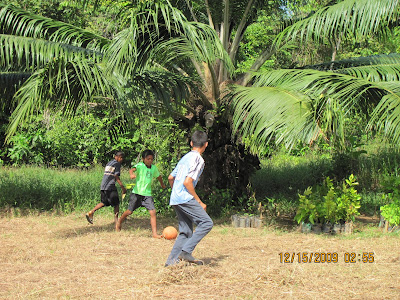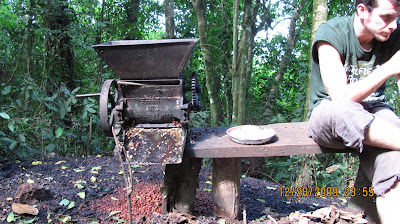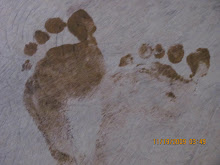
The mud began to dry at last. Each day of sun made the roads more passable. This particular road stretches 7 hours to San Pancho, which had served as one of my bases for visits to productors in the campo. Each day I saw more families make the long trek from their home in the campo to the big city of Bluefields. The other day I was shocked to find a FUNCOS productor whosde farm I´d visited in Las Breñas, bathing with her dfaughter by the bridge on my road, having just arrived after an 8 hour hike from her home. Likewise, large trucks from Bluefields began to venture up the road carrying all sorts of provisions for these far flung communities, who normally receive all they need by boats that travel up and down river.

The drying of the road meant that I could finally leave the farm without my rubber boots, though I have to stomp harder as I walk the path to the farm to avoid startling any snakes in the tall grass. Under these conditions we could also welcome Doña Coco's kids, a group of street children that are gathered daily and informally for breakfast, lunch, and a bit of life coaching. Each day they made the four hour round trip hike to the farm in their chinelas, or flip flops. And so began my work with local kids at the farm.

In my past three years working at Groundwork Somerville, I would lead a week long April Vacation camp for elementary aged kids, where we would cook our own meals, prep the soil and sow seeds, visit a nearby rural farm, and explore the environment through "urban adventure hikes." This week brought me back to those vacation camps and my work with students in Somerville who are not so different from these children. However, Doña Coco's kids, endearingly called, have little to no support from parents or other family members. With poor influences at home, drug and alcohol abuse, few show up to school and many work the streets. Ranging in age from 8- 17, they are used to looking out for each other and operate like a group of orphaned brothers. They come by Doña Coco's mess hall each day to receive meals (supported by an American gifting $200/ month) and a little positive influence that hopefully encourages them to continue with their schooling.


They came each day to double dig the rows for the vegetable garden and germination area, that I had long become tired of pick- axing alone. They showed up ready to work, though their attention waned after 45 minutes, much like the Somerville students, and before long, I began to see stones hurled over my head. The first day I saw two kids tumbling and throwing punches out in the field. I waited to see how the supervisors would handle the conflict. When no one stepped in, all forty kids grabbed a stone or a tool and ran out into the field Lord of the Flies style. I realize I have a long way to go in understanding the way adults rear children here. Regardless, after that day, I laid down my own rules of the farm. It was obvious to me that the children were eager to receive a bit of forceful direction and rules, paired with kindness and caring.

On their first day, as their attention began to wane in the field, I tested their innocense by teaching them the famed "worm rap" that I have been teaching kids in Somerville for three years. Many being Creol speakers, I was able to teach them the rap in English with no trouble and for the remainder of the week, from all parts of the farm you could hear kids calling out the verses and swaggering their hips along to the beat. It was this sweet and earnest showing of interest to learn and to behave like the children that they are, that warmed my heart and allowed to me to look beyond their occasional inappropriate actions, the way one eight year old would follow me around talking to me like a sex object because that's what he was used to hearing, or the children who hoarded stones from the farm to throw at dogs on their way home, as well as the boy who lost control and smashed a metal rake over my pointer finger-- there's still a bump.


That Saturday, following a full week of work, I made my way downtown. Immediately I came across one of the children selling fruit on the street. I bought three mandarinas from him and promised he would be back to the farm following New Years. Further down the street I ran into another of the children shining shoes. I offered him a mandarina and sat down to chat for a few minutes. I continued to hear my name or verses of the worm rap called out as I rounded corners of Bluefields Center, each greeting was met by a request to come back to the farm. Just like my experiences with the guys my age I meet at Georgina's Farm, if I encountered them for the first time on the street, I'd likely hear the same hissing or nasty sexual remarks that define my walks through town. However, encountering these youth for the first time on the farm has helped them to understand the gringa and for me to understand them. And in this way Bluefields becomes more of a home to me each day.



************************************************************************************
 I am writing now from Granada as I make my way back to Bluefields following a week and a half on beautiful Isla Ometepe, a figure eight island, a volcano in each bubble, that sits in the middle of Lago Nicaragua. I passed my time in the provincial island towns of Balgue, El Madronal, and Merida for the holidays with a terrific mix of locals and travelers from all over the world, who so easily and naturally become good friends when sharing such natural beauty and tranquility. I enjoyed a respite from classic Nica music in favor of guitar sessions and a break from beans and rice in favor of brick oven sourdough bread, honey, jams and tahini that we made on site at the permaculture farm where I stayed. I most enjoyed the way any Nica would strike up a conversation with me if we were walking in the same direction down the road.
I am writing now from Granada as I make my way back to Bluefields following a week and a half on beautiful Isla Ometepe, a figure eight island, a volcano in each bubble, that sits in the middle of Lago Nicaragua. I passed my time in the provincial island towns of Balgue, El Madronal, and Merida for the holidays with a terrific mix of locals and travelers from all over the world, who so easily and naturally become good friends when sharing such natural beauty and tranquility. I enjoyed a respite from classic Nica music in favor of guitar sessions and a break from beans and rice in favor of brick oven sourdough bread, honey, jams and tahini that we made on site at the permaculture farm where I stayed. I most enjoyed the way any Nica would strike up a conversation with me if we were walking in the same direction down the road.
The highlight of my trip was encountering an older Ometepeian on the road who, upon hearing that I was from Philly, informed me that he has been living and working at the Showboat Casino in Atlantic City for the past 23 years. We were both headed in the direction of the Fiesta Patronales, an excuse for people to participate in the biggest drunken disaster of a rodeo I've ever seen. He let me ride his horse down the road, treating me to a beer before entering the ring.

Here in Nicaragua, we fell asleep at midnight on Christmas eve to firecrackers going off and parades through town, rather than warm milk and cookies, and woke on Christmas morning to firecrackers going off at 5am, rather than gifts under a tree. A holiday doesn't pass through this country without a loud chorus of firecrackers, some Flor de Cana rum or the local aguardiente, and a couple pinatas.

I am looking forward to returning to the lush Caribbean to continue my work at the Demo Farm and Georgina's farm, possibly splitting my living arrangements between the wonderful family of five living off the grid at the farm, and the peaceful home of Georgina, the Swiss expat, and Berlin, a 26 year old Nicaraguan, who live with two lovely dogs by the bay in barrio Santa Rosa.

Hoping everyone's holidays were overflowing with snowflakes, mulled cider, musical festivities and love.
for excerpts of this blog and another article titled, A Hunger for Compassion, link to SHI´s website:
http://sustainableharvest.org/news-articles/articles/newsletter-articles/a-hunger-for-compassion
for more photos of Doña Coco´s kids at the farm, link to SHIs flickr page:
http://www.flickr.com/photos/sustainableharvest/sets/72157621960064797/

















































